Again Please NOTE: Since our massive Radiator Round Up was completed, the thermal testing rig was retired and parts pulled from it for use in other projects. However, the rig was recommissioned for two reviews, but after several days testing we were never able to get the same calibration on the rig. Therefore we are not able to compare (apples to apples) these recent results with data previously recorded. Because of this we re-tested a couple of radiators with the new calibration so that we do have some results to compare the Eisbrecher Pro XT45 against. However in order to save time with these retests we streamlined the testing and stripped out the 0.5 GPM and 1.5 GPM Push/Pull tests.
This first table shows the Eisbrecher Pro’s W/10ΔT numbers in a quick glance chart format.
 and now our “Modified” version.
and now our “Modified” version.
We have striven from the beginning of our radiator testing to achieve a test error margin of 1% or less. Initially we ran tests for months to verify data was accurate and repeatable before we commenced testing to publish the results. With our test equipment and methodology we believe we produce the most accurate data available for PC radiator thermal dissipation.
Push Only Data vs Competition
Focusing on the Push Only results for now, we’ll get to the Push/Pull data later.
Let’s start with 750 RPM and see how the Eisbrecher Pro compares.
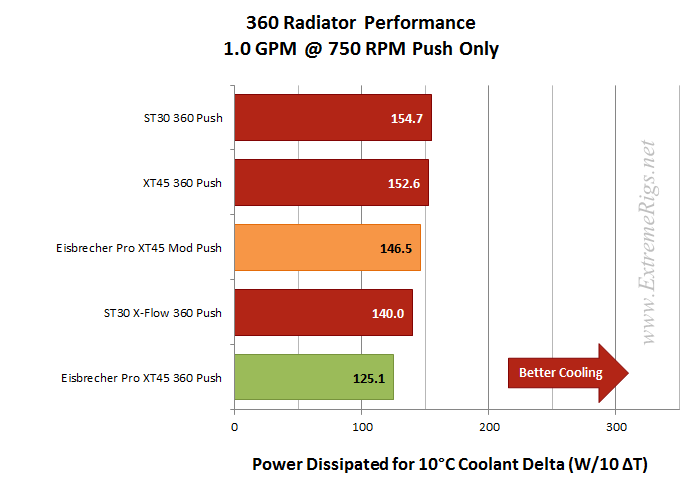 The Eisbrecher Pro finished last for Push Only at 750 RPM. Not only was it beaten by the modified version and the regular XT45 but also the 2 ST30 variants placed ahead of it. We offer explanations for this in our recently published ST30 X-Flow Review. For now we should probably focus on the XT45 variants and try to ignore the ST30 and ST30 X-Flow results.
The Eisbrecher Pro finished last for Push Only at 750 RPM. Not only was it beaten by the modified version and the regular XT45 but also the 2 ST30 variants placed ahead of it. We offer explanations for this in our recently published ST30 X-Flow Review. For now we should probably focus on the XT45 variants and try to ignore the ST30 and ST30 X-Flow results.
Now let’s look at 1300 rpm:
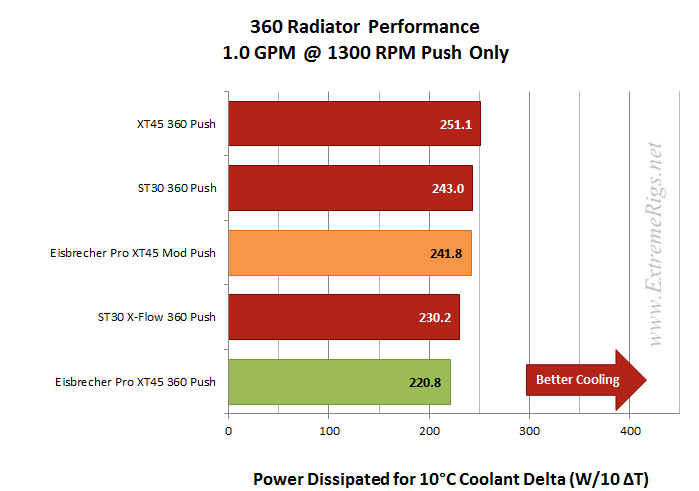 Here we see the same placings for the XT45 variants as in the 750 RPM results. The finishing order is exactly as we expected for the XT45 variants; least restriction to air flow on top (XT45) through to most air flow restriction at the bottom (Eisbrecher Pro).
Here we see the same placings for the XT45 variants as in the 750 RPM results. The finishing order is exactly as we expected for the XT45 variants; least restriction to air flow on top (XT45) through to most air flow restriction at the bottom (Eisbrecher Pro).
Now 1850 rpm Push Only:
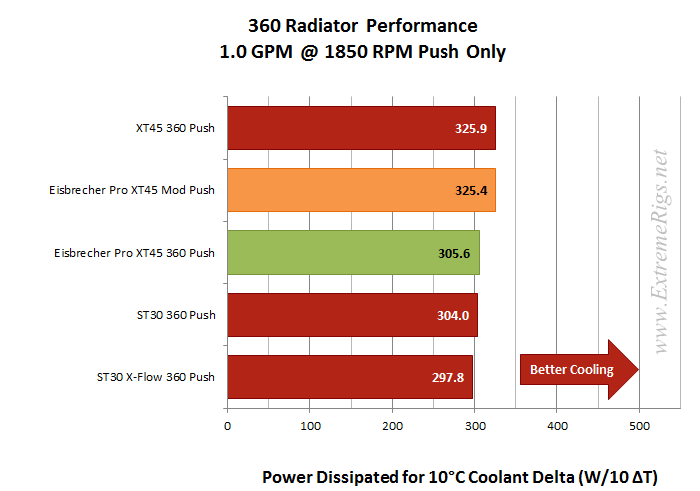 Now all the XT45 variants fill the top 3 placings and are again in the order we expect. But notice now our Modified version is virtually identical to the regular XT45. We did not expect that it would get so close because of the grill on each side. We thought the grills would have more of an impact on the air flow/pressure. This got us to thinking what else could be effecting performance.
Now all the XT45 variants fill the top 3 placings and are again in the order we expect. But notice now our Modified version is virtually identical to the regular XT45. We did not expect that it would get so close because of the grill on each side. We thought the grills would have more of an impact on the air flow/pressure. This got us to thinking what else could be effecting performance.
The 11.5mm internal shroud heights of the Eisbrecher is nearly double the 6mm that is on the XT45. So we believe that the deeper shroud helps the Modified Eisbrecher reduce the deadzone once there is enough airflow. At lower rpm the air pressure is not enough to “push through” the extra shroud and grill with the same airflow.
One more chart to share for Push Only. Here we have plotted the Eisbrecher Pro against the other XT45 variant radiators in Push Only.
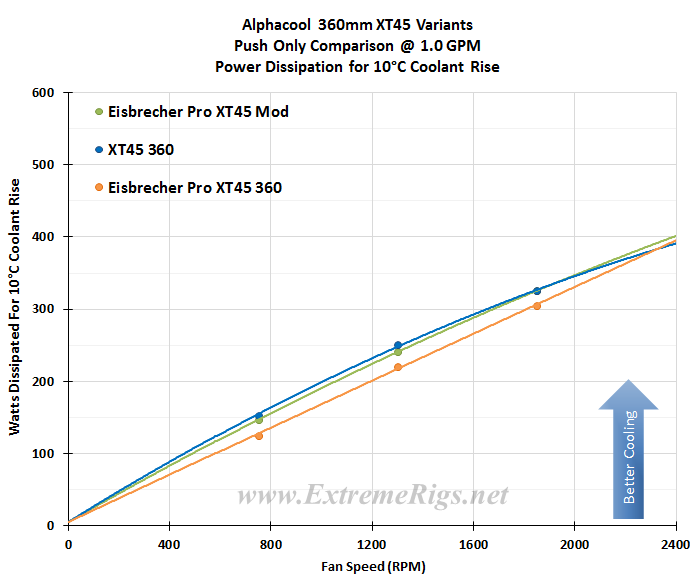 The difference does not look as much on XY plotted chart as on the bar charts above, but clearly the Eisbrecher Pro’s performance is being effected by the ABM. On average it is 11% weaker than the Modified version for Push Only. The difference was as low as 6% at 1850 RPM but was a massive 17% variation at 750 RPM.
The difference does not look as much on XY plotted chart as on the bar charts above, but clearly the Eisbrecher Pro’s performance is being effected by the ABM. On average it is 11% weaker than the Modified version for Push Only. The difference was as low as 6% at 1850 RPM but was a massive 17% variation at 750 RPM.
The Eisbrecher Pro produced disappointing results with Push Only fans and we can only hope for an improvement when run with a Push/Pull assembly.
Keep in mind that with a Push/Pull fan assembly you are dealing with a 106mm thick cooler pack and that simply will not fit in many installation scenarios.
Push/Pull Data vs. Competition
Again only 1.0 GPM comparison results are being displayed due to the trimmed down testing regime that was implemented.
Firstly the 750 rpm:
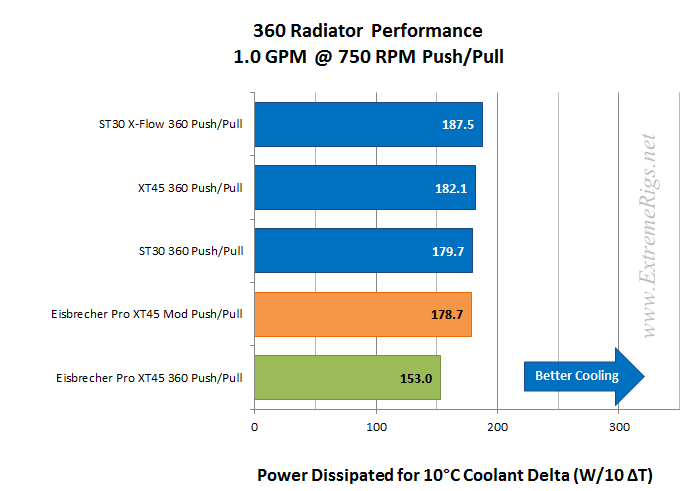 Here the Eisbrecher Pro is in last place again and was ~15% behind our Modified version.
Here the Eisbrecher Pro is in last place again and was ~15% behind our Modified version.
Let’s move to 1300 rpm:
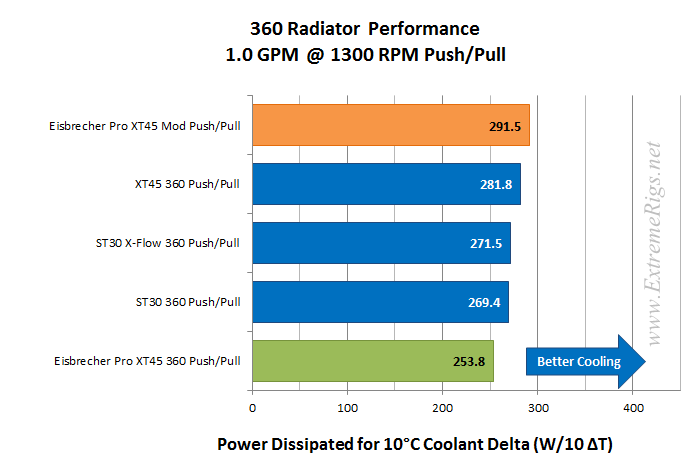 At 1300 rpm the Eisbrecher Pro again lands in last place, now ~13% behind our Modified version which somewhat surprisingly finishes 1st, ahead of the regular XT45. Again we offer the increased shroud depth on the Modified Eisbrecher as the reason why it outperformed the XT45.
At 1300 rpm the Eisbrecher Pro again lands in last place, now ~13% behind our Modified version which somewhat surprisingly finishes 1st, ahead of the regular XT45. Again we offer the increased shroud depth on the Modified Eisbrecher as the reason why it outperformed the XT45.
Now 1850 rpm:
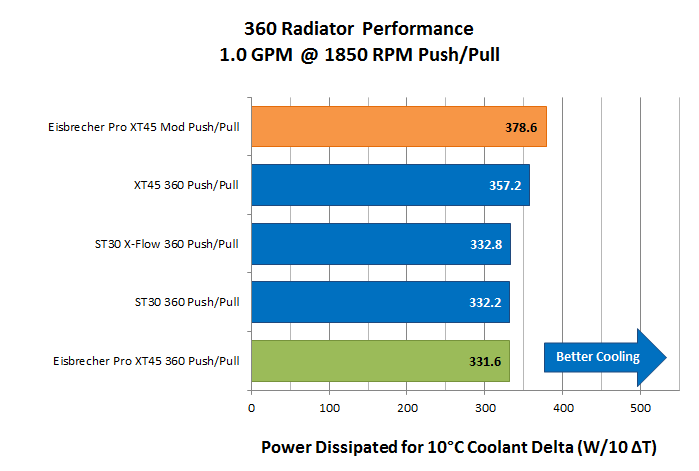 The Eisbrecher Pro again has very disappointing results, however our Modified version proves to have been a winner.
The Eisbrecher Pro again has very disappointing results, however our Modified version proves to have been a winner.
This plot really shows how the Modified Eisbrecher pulls away from the vanilla XT45 as RPM increases, and it also clearly shows just how big an impact the ABM has.
Let’s now place the data for Push Only and Push/Pull at 1.0 GPM for each fan speed together so we see both sets of results on the same plot. Sometimes these combined plots show up some points of interest even though it is a repeat of data we have already looked at separately.
Again the 750 rpm first:
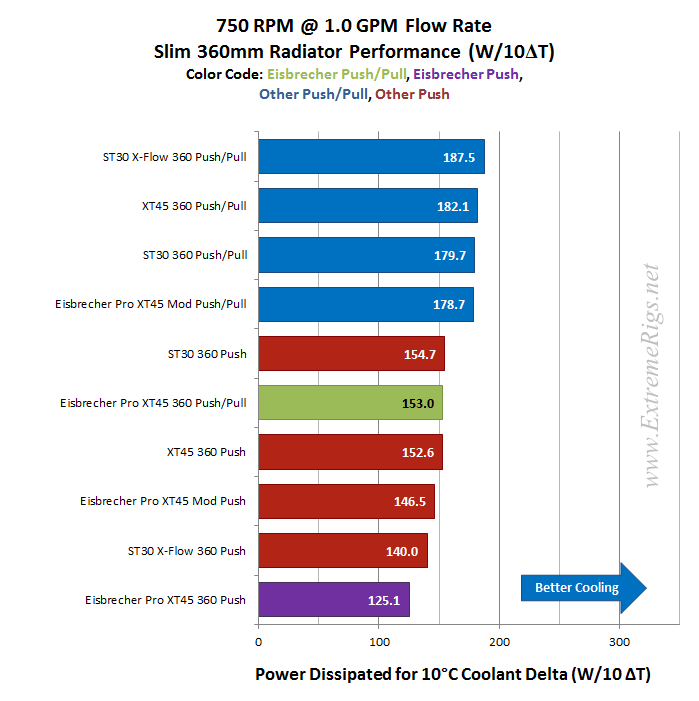 It is a small test group of just five radiators so perhaps the results here are exaggerated somewhat, but plots like these can really show both the very dominant and the very weak results. In the above plot for example the ST30 Push Only result has beaten the Eisbrecher Pro with Push/Pull. This is pretty embarrassing for the Eisbrecher given that we are comparing a 55mm setup with a 106mm thick setup.
It is a small test group of just five radiators so perhaps the results here are exaggerated somewhat, but plots like these can really show both the very dominant and the very weak results. In the above plot for example the ST30 Push Only result has beaten the Eisbrecher Pro with Push/Pull. This is pretty embarrassing for the Eisbrecher given that we are comparing a 55mm setup with a 106mm thick setup.
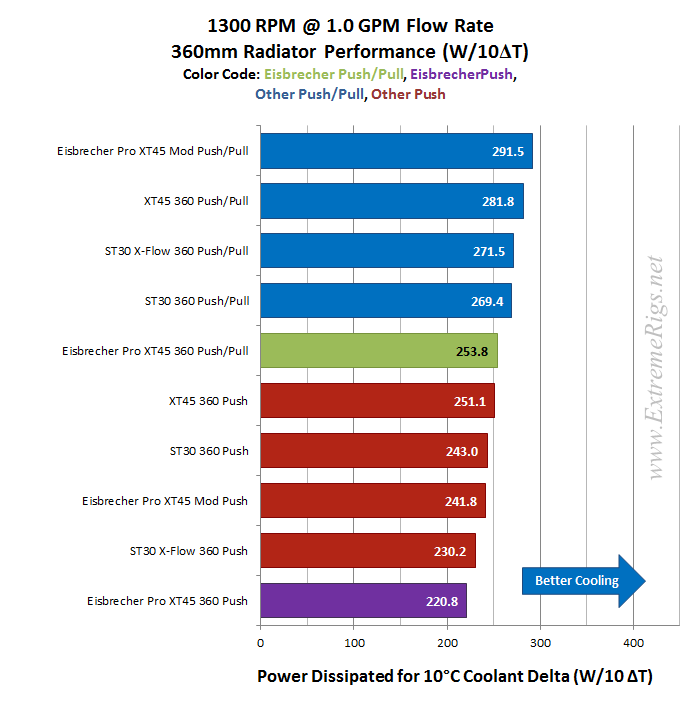 At 1300 RPM the Eisbrecher Pro with Push/Pull fans barely beats the XT45 in Push Only. Clearly the Eisbrecher Pro has performance issues.
At 1300 RPM the Eisbrecher Pro with Push/Pull fans barely beats the XT45 in Push Only. Clearly the Eisbrecher Pro has performance issues.
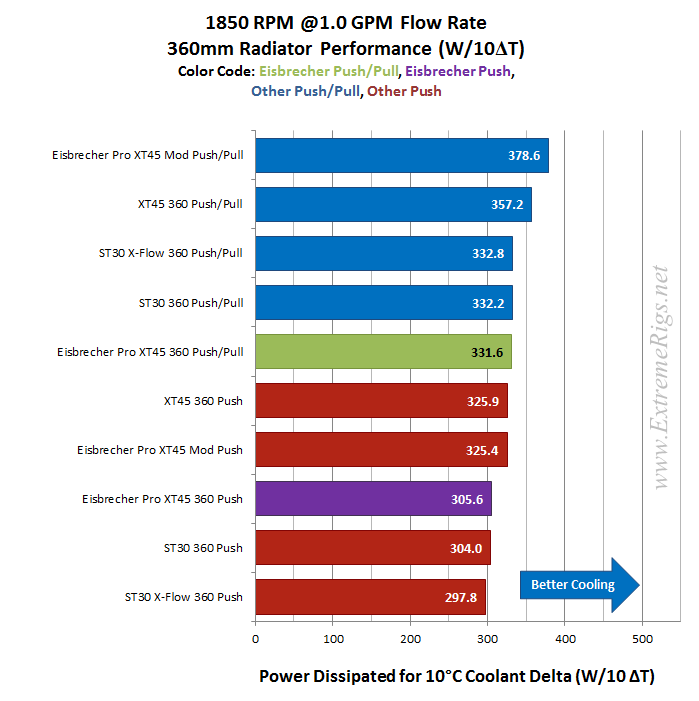 So we have some pretty nasty thermal performance results for the Eisbrecher Pro, but with a simple modification we’ve proved it can perform quite well.
So we have some pretty nasty thermal performance results for the Eisbrecher Pro, but with a simple modification we’ve proved it can perform quite well.
From all the test results we created “Average Performance Factor” charts for both Push and Push/Pull. We then made a combined plot of the average called the “Master Performance Factor”. The radiator with the best cooling ability (W/10ΔT) at each rpm was awarded a score of 100. Each other radiators W/10ΔT result was scored as percentage of the top performer.
This way of looking at the comparison takes away any advantages that a radiator may have at higher or lower fan speeds and looks at an overall average. While this appears fair it does tend to favor those radiators that are all-rounders and those radiators which do very well at high RPM. Most users should be more focused on their specific use case.
Here are the Eisbrecher Pro’s percentage scores at each data point:
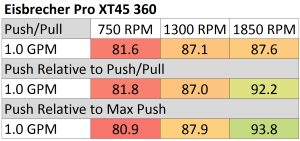 and also for our Modified version.
and also for our Modified version.
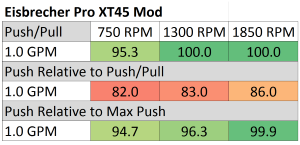 You may have guessed; low scores with red boxes are not so good for the Eisbrecher Pro, while high scores and green for the Modified version are great.
You may have guessed; low scores with red boxes are not so good for the Eisbrecher Pro, while high scores and green for the Modified version are great.
However, as the percentage scores in the table above are relative to the best performer at each data point, we again advise readers to cross reference specifications and results for each radiator and keep in mind your intended fan assembly and operating speed.
The percentage numbers above offer another way of comparing the Eisbrecher Pro’s results. But for our scoring system we need a way to reduce the categories while retaining the data. To do this we average the results for each fan assembly type giving us Averaged Performance Factors. We calculate this for Push Only, Push/Pull and finally an average of everything. Again only the 1.0 GPM data has been used.
Firstly – the Push Only APF:
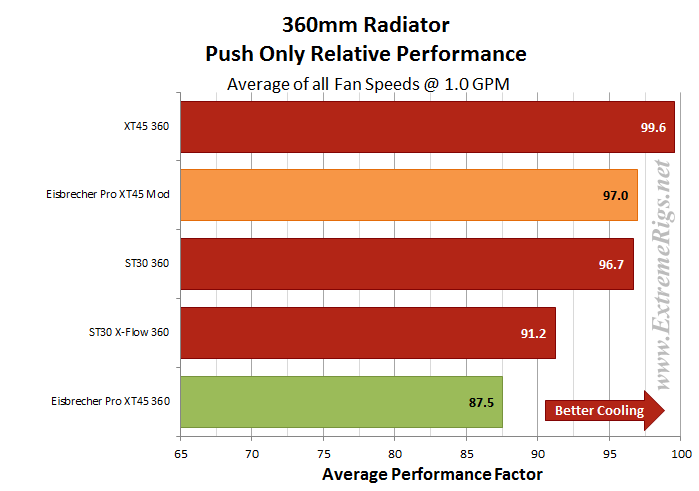 With an 87.5 % Averaged Push Only result the Eisbrecher Pro finished as the weakest performing radiator of the test group. We can only conclude that the ABM is a failure and as we suspected it would reduce air flow more than it would “evenly distribute” it.
With an 87.5 % Averaged Push Only result the Eisbrecher Pro finished as the weakest performing radiator of the test group. We can only conclude that the ABM is a failure and as we suspected it would reduce air flow more than it would “evenly distribute” it.
Now the Push/Pull APF:
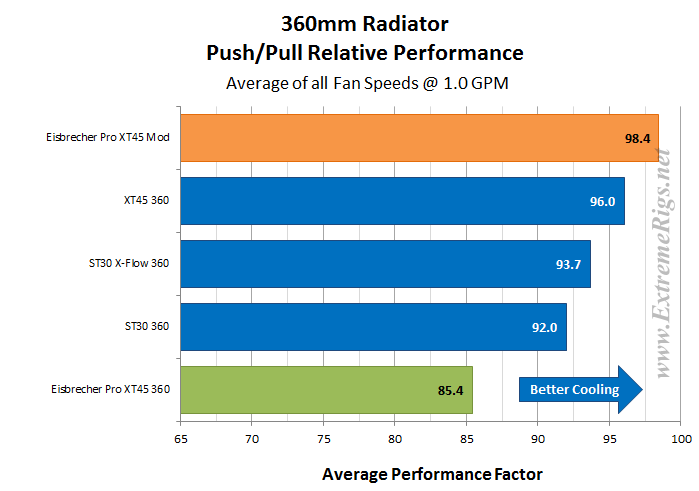 In the Push/Pull APF the Eisbrecher Pro finishes last again with an 85.4 Push/Pull APF score. We are pleased though that the Modified version placed first.
In the Push/Pull APF the Eisbrecher Pro finishes last again with an 85.4 Push/Pull APF score. We are pleased though that the Modified version placed first.
Finally for thermal performance we created the Master Performance Factor which is calculated from the averaged results of all the Push Only and Push/Pull thermal tests.
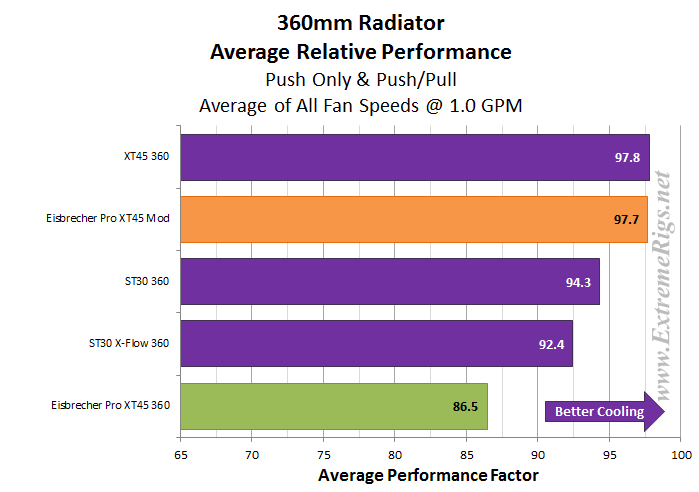 The MPF result of 86.5 places the Eisbrecher Pro last overall for performance and quite some margin behind even the slim radiators. The Modified version placed equal first with the XT45.
The MPF result of 86.5 places the Eisbrecher Pro last overall for performance and quite some margin behind even the slim radiators. The Modified version placed equal first with the XT45.
Space Efficiency
The Eisbrecher Pro’s space efficiency vs. performance score is going to be very low because it is the thickest of the group and has the worst performance. We have used the Average Performance Factor results from the charts above to compile two plots which shows us how it compares to the other radiators in terms of performance Vs. space taken.
Firstly is radiator thickness Vs. APF
Here the combined APF scores were divided by the only radiator thickness, with the highest (most space efficient) issued a score of 100. Each of the other radiators results was converted to a percentage of the most space efficient radiator’s score.
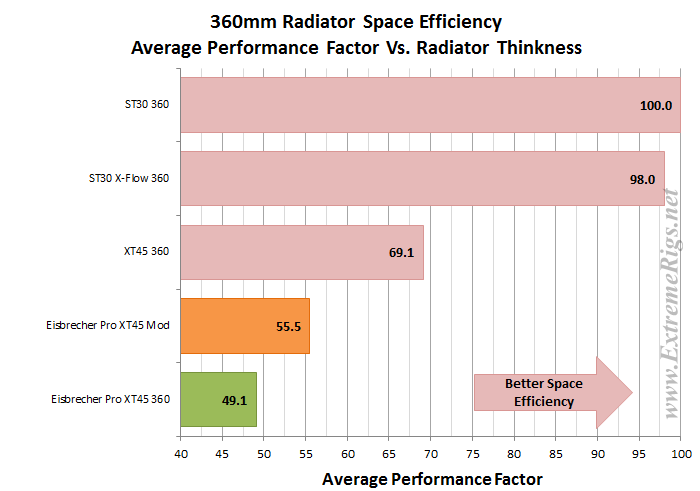 The results end in order of thinnest to thickest and we can see just how much impact the thickness of the radiator has on this metric by looking at the Modified Eisbrecher result. It finished equal 1st for thermal performance but is 2nd last here with a score of just 55.
The results end in order of thinnest to thickest and we can see just how much impact the thickness of the radiator has on this metric by looking at the Modified Eisbrecher result. It finished equal 1st for thermal performance but is 2nd last here with a score of just 55.
Next we took the APF results for Push/Pull and divided it by the total thickness including the fans and applied the same scoring system. For the Push Only we used the Push Only Vs Push/Pull comparative results and applied the same scoring system when compared against the Push/Pull.
The rankings are ordered for Push Only as that is the most efficient fan assembly and each radiator’s Push/Pull result are placed un-ordered, just below it’s ranked Push Only score.
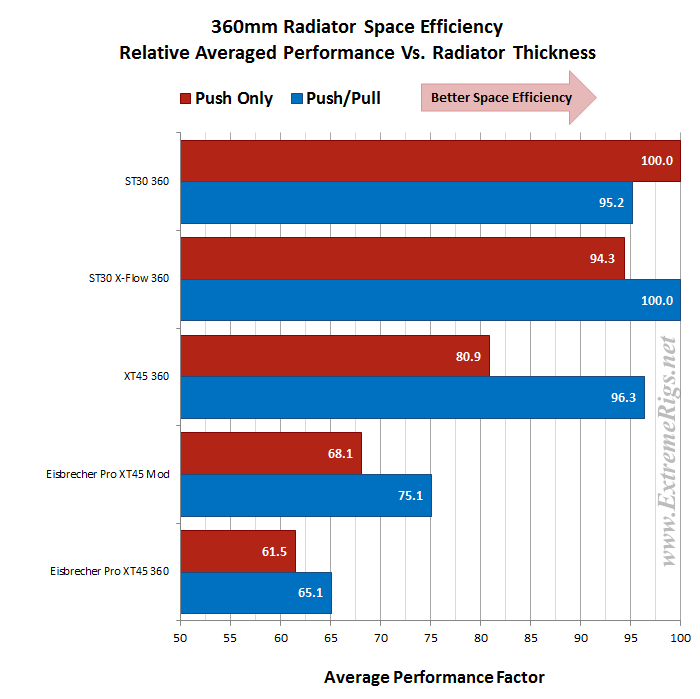 This plot is likely the most useful for readers of the 2 plots for space efficiency even though it is harder to decipher, especially the Push/Pull rankings. With fan thickness factored in the Eisbrecher Pro’s scores improve, but it is still in last place.
This plot is likely the most useful for readers of the 2 plots for space efficiency even though it is harder to decipher, especially the Push/Pull rankings. With fan thickness factored in the Eisbrecher Pro’s scores improve, but it is still in last place.
Value Factor
While our APF’s are still fresh in mind, let’s now look at some performance results vs radiator price to show which of the 360mm radiators might offer the best bang for your buck. Each radiator’s combined APF scores were divided by the radiator cost and again we applied our scoring system of percentage Vs. the best performer of the category.
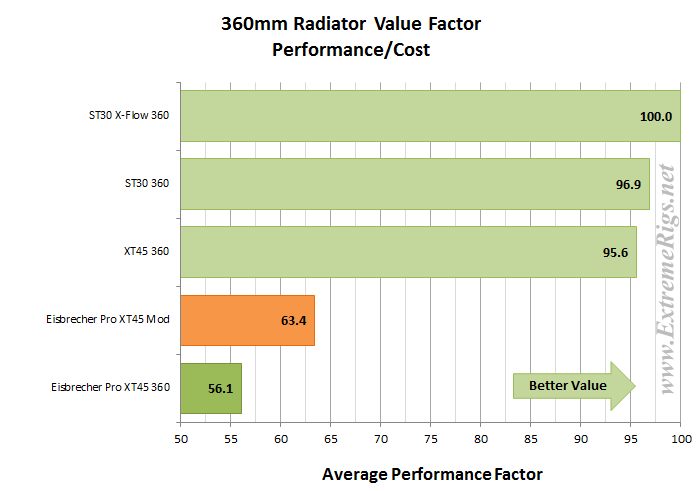 The Eisbrecher Pro’s Value Factor is very low due to it’s higher cost. Even the Modified version which had terrific comparative thermal test results has a weak score in this metric. The Eisbrecher Pro is so far behind the regular XT45 that it’s safe to say buyers of the Eisbrecher Pro better not be concerned with performance per dollar spent.
The Eisbrecher Pro’s Value Factor is very low due to it’s higher cost. Even the Modified version which had terrific comparative thermal test results has a weak score in this metric. The Eisbrecher Pro is so far behind the regular XT45 that it’s safe to say buyers of the Eisbrecher Pro better not be concerned with performance per dollar spent.
Next Up – Summary!









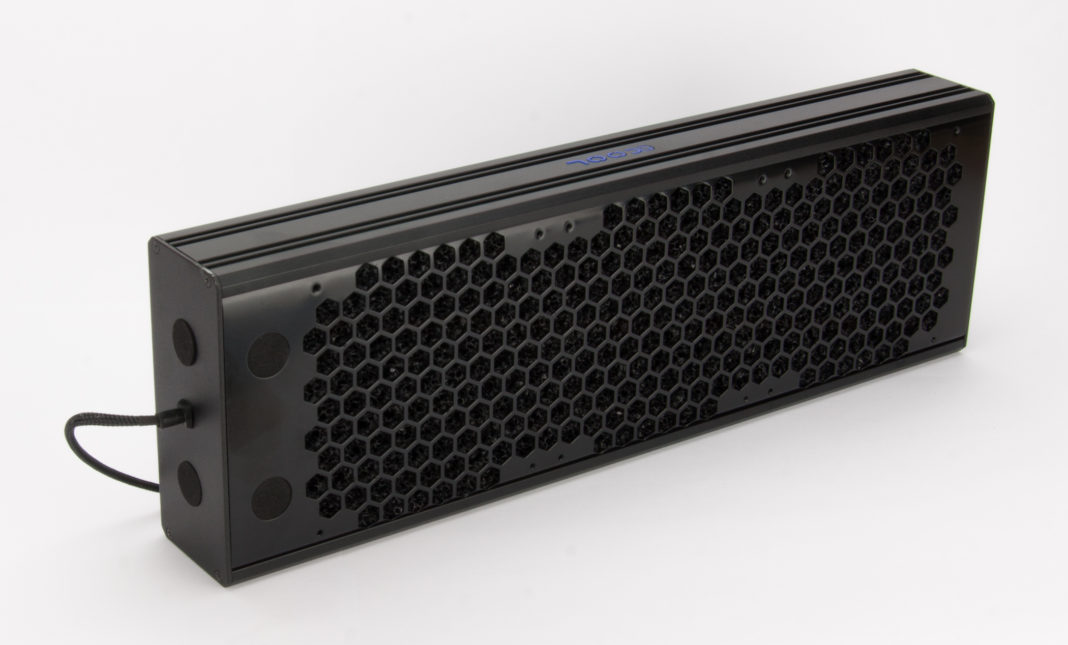

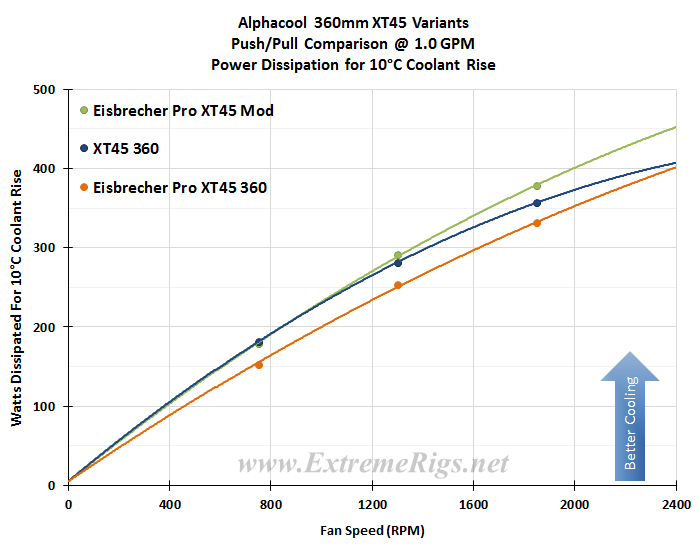



I’m guessing they had to add the ABM cause the rads enclosure was generating noise as the fans pushed air through it.
Comments are closed.